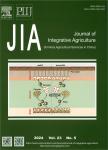Recent advances in immunocastration in sheep and goat and its animal welfare benefits:A review
Recent advances in immunocastration in sheep and goat and its animal welfare benefits:A review作者机构:Key Laboratory of Agricultural Animal GeneticsBreeding and Reproduction of Ministry of EducationHuazhong Agricultural UniversityWuhan 430070P.R.China Laboratory of Sheep and Goat GeneticsBreeding and ReproductionCollege of Animal Science and TechnologyHuazhong Agricultural UniversityWuhan 430070P.R.China
出 版 物:《Journal of Integrative Agriculture》 (农业科学学报(英文版))
年 卷 期:2022年第21卷第2期
页 面:299-309页
核心收录:
基 金:funded by the National Natural Science Foundation of China(31972997 and 31772598) the China Agriculture Research System of MOF and MARA(CARS-38)
主 题:immunocastration reversibility safety animal welfare DNA vaccine
摘 要:Castration of male animals is a common practice in the meat industry aimed at reducing aggressive behavior, preventing unpleasant flavor, and controlling undesirable breeding. For many years, mechanical castration and surgical castration have been practiced to sterilize the animals. However, these castration methods are not humane because of the associated risk of death, pain, and stress. Recently, immunocastration targeting the hypothalamic-pituitary-gonadal axis(HPG) axis has been reported as an animal-friendly approach that circumvents many of the concerns with conventional castration, and suggested by researches as an alternative to surgical castration. However, there is no compilation of updated information on the use of immunocastration in sheep and goats. Therefore, this review aims to summarize the developmental process from traditional surgical castration to immunocastration and to screen the process of immune targets. It also compares the respective advantages and disadvantages of traditional castration technologies and immunocastration, in particular including analyses in the characteristics, features application and welfare benefits of immunocastration in sheep and goats were also analyzed.



